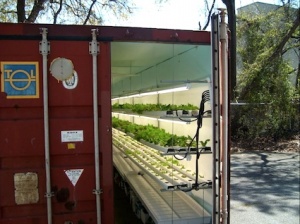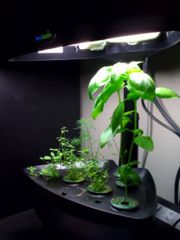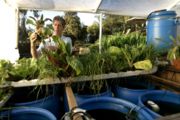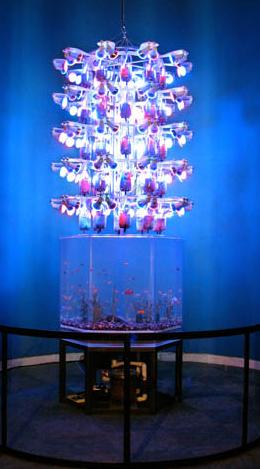Difference between revisions of "Food"
| Line 7: | Line 7: | ||
<!-- ******* START OF LEFT COLUMN ******* --> | <!-- ******* START OF LEFT COLUMN ******* --> | ||
<div style="float:left; width:50%;"> <!-- This width add to the the margin below to equal 100%--> | <div style="float:left; width:50%;"> <!-- This width add to the the margin below to equal 100%--> | ||
| − | |||
{{frame1|Controlled Environment Agriculture and Automation}} | {{frame1|Controlled Environment Agriculture and Automation}} | ||
</div> | </div> | ||
| Line 14: | Line 13: | ||
<div style="float:right; width:49%"> <!-- This margin should be right of the above --> | <div style="float:right; width:49%"> <!-- This margin should be right of the above --> | ||
{{frame1|Aquaculture and aquaponics}} | {{frame1|Aquaculture and aquaponics}} | ||
| − | |||
</div> | </div> | ||
{{portalpageend}} | {{portalpageend}} | ||
Revision as of 02:22, 24 April 2010
|
Many people believe that we are soon to face a global food shortage. Population is rising rapidly, with a billion people added in less than ten years. 40% of farming land has been depleted
 and rainforests have been cut down to make more room for farming. Farmers are moving into cities at the rate of over a million a week [1], and our appetite for meat is growing[2]. These trends means that food demand is rising, but there are fewer farmers to supply it, while the basis of our agricultural production is under strain. It would indeed seem that we are heading for a food crisis. and rainforests have been cut down to make more room for farming. Farmers are moving into cities at the rate of over a million a week [1], and our appetite for meat is growing[2]. These trends means that food demand is rising, but there are fewer farmers to supply it, while the basis of our agricultural production is under strain. It would indeed seem that we are heading for a food crisis.
But this story misses a key point: there are far better ways to produce food than the ones now in wide use. While it is true that conventional plough agriculture and monoculture is driving the world towards a food crisis, there are ways to grow food using very little land, very little labour and no pollution. The aim of this page is to explore these methods and show how they can comfortably sustain a growing population. Any food shortage is really a shortage of applying this know-how to food production. It is possible, with current know-how, to create a food-production system that can provide tens of billions of people with abundant, local, nutritious, tasty food, textiles and wood, while economizing water, restoring soil, building communities, saving energy, creating pleasing landscapes, preserving wilderness, stopping diseases, needing virtually no inputs and benefiting not just people, but the rest of the biosphere as well. Aeroponics is the art of growing plants with their roots in air rather than in soil. The roots are intermittently spraying with nutrient-enriched water. This allows for precise control of the amount of nutrients that the plants receive. The figures on Wikipedia show that growing plants hydroponically (with their roots in nutrient-enriched water) results in yields 50% to over 1700% higher than growing in soil. Aeroponics yields are higher yet [3] [4]. show that growing plants hydroponically (with their roots in nutrient-enriched water) results in yields 50% to over 1700% higher than growing in soil. Aeroponics yields are higher yet [3] [4].
By growing aeroponically indoors, we can create an environment that can be monitored and controlled electronically. This lends itself readily to automation. A controlled environment allows food to be grown year-round, independent of seasons. While only one harvest a year can be grown conventionally, constant-yield growth gives 4-30 harvests a year, depending on the plant. Growing indoors greatly reduces the threat of pests and plant-diseases, eliminating the need for pesticides. And best of all, by optimizing the nutrient flow, we can supply plants with the nutrients they need to produce the flavonoids that give them their flavour. With controlled growing, it is possible to achieve a more intense flavour than growing in soil. Aeroponics requires an input of water with dissolved mineral salts, but it uses these resources very efficiently. Hydroponics uses only 5-10% the water of agriculture [5], while aeroponics uses 65% less water than hydroponics and only a quarter the nutrients [6]. Such water-efficient growing will make huge difference if we want to preserve our water resources, as 69% of all our water use is for agriculture [7]. Both of the necessary inputs for aeroponics - water and minerals - are in enormous abundance on Earth. LEDs can efficiently satisfy the light requirements of plants. Experiments by the University of Manitoba found that LED lighting increases yields by about 40% [8]. LEDs could be useful in situations where sunlight is unavailable - such as in winter in regions far from the Equator, in underground or underwater dwellings, in cities where a demand for space means food must be grown on stacked shelves indoors, and in space habitats. Currently the main obstacle to large controlled-environment agriculture projects such as The Vertical Farm Project is the cost of energy for lighting. As LEDs become cheaper and more energy-efficient (as with recent developments in OLED and PHOLED technology) these projects become more and more feasible. Fibre-optic cables can pipe sunlight in from outdoors, significantly reducing the amount of energy needed. Omega Garden uses an innovative cylindrical design in which plants are constantly tilted so they have to adjust to gravity[9]. It is claimed that this method can result in a fivefold increase over other plants grown in the same conditions but without rotation. There are many tricks that can be used to increase yield in controlled-environment growing that are not feasible on farms. Increasing carbon dioxide concentration in the air can increase yield 30-50%. Supplementing with fulvic acid can increase yield over 30%. Plant hormones such as gibberellin increase yields significantly. Even with none of these tricks, a hydroponic garden can regularly grow 2kg of vegetables a day (more than enough to nourish a person) in 20 square meters [10]. An aeroponic garden using LEDs, CO2, plant hormones and fulvic acid could grow the same amount in perhaps half the space. Furthermore, it is possible to stack five layers of crops one on top of another in a 2m high system, reducing footprint fivefold. The surprising result is that in the near future, city-dwellers will be able to grow most or all of their own food in their kitchen - farming will not be necessary for food-production. Space colonists could also grow food locally using aeroponics and in-vitro meat.Dickson Despommier, an advocate of vertical, controlled-environment farming, has painted a picture of what controlled-environment growing might be like -
 PodPonics is one existing proof-of-concept; it grows an acre's worth of food in a single 320 square foot (30m2) shipping container. Food produced in this way is local, fresh and delicious.
Moreover, a gas chromatograph will tell us when to pick the plant by analyzing which flavenoids the produce contains. These flavenoids are what gives the food the flavors you're so fond of, particularly for more aromatic produce like tomatoes and peppers. These are all right-off-the-shelf technologies. The ability to construct a vertical farm exists now. We don't have to make anything new." Algorithms could be developed and shared online to model how nutrient flow, timing, duration, intensity and color of light, and strains of plants used affects food yields and flavour. PlantLab is a company that is compiling exact, programmable specifications for growing various plants, but open-source methodology has proven to be a much faster way of compiling large streams of experimental data. Programming these algorithms into computers that control the LED lights and the nutrient flow in the aeroponic system would yield a truly automated food-production system that anyone could use to grow their own food indoors. All this technology exists currently, and is being constantly improved and refined. Hydroponics is growing plants in water. Aquaculture is growing fish in tanks. The disadvantage of hydroponics is the constant input of mineral nutrients it needs. The disadvantage of aquaculture is the difficulty of keeping the water clean. Aquaponics combine the two systems and thereby cancels out the weaknesses of both. In aquaponics, edible fish are grown in a tank. The fish eat the algae that will grow naturally in nearly any still body of water, or pond weeds can be grown. (Most aquaponic systems now use fish food, but methods under development eliminate the need for this input by cultivating duckweed or algae.) The fish effluent enriches the water with nutrients. This water then serves as the medium to grow hydroponic herbs and vegetables. The roots of the herbs and vegetables, and the bacteria that grow around them, clean the water for the fish. Both the fish and the plants can be eaten by humans. Some aquaponics systems also include a wormery, which uses the inedible parts of the plants to feed worms. The worms are then fed to the fish and the compost they produce can be used to nourish more plants, or made into compost tea to add more nutrients to the hydroponic system. This brings the system closer to a fully closed-loop that recycles all its waste. It should be apparent from this description that aquaponics is an extremely resource-efficient method of food production. No fertilizers are needed and there is no pollution. It is really the only sustainable way of producing fish; much more sustainable than conventional fish-farming and certainly more sustainable than current fishing practices. In theory an aquaponic system could be run without external input (though in practice fish food and calcium and other minerals often need to be supplied.) Aquaponics requires 10% the water of growing vegetables in soil, because the water is constantly recycled rather than draining away. This means that aquaponic farms nearly anywhere in the world can run on rainwater alone. Aquaponics is extremely productive. The plant yields compare favorably with hydroponics, and are much higher than growing in soil. Some research even points to the possibility of achieving much higher yields with aquaponics than even with hydroponics[11]. The aquaponics system at the University of the Virgin Islands[12] grows over 4000kg of tilapia and over 2500kg of okra yearly. This is more than enough fish for 35 people and more than enough vegetables for four people and it is all grown on just 500m2 of space. And this system does not even use space optimally; the 500m2 figure includes the gaps between the tanks. Improvements on the University of the Virgin Islands system have since been made [13][14]. Growing Power is an urban farm in Milwaukee. It uses several methods of growing, but aquaponics is the main one. On a footprint of just three acres (12,150m2), they grow enough food for 10,000 people[15]. Over the next few years, as a result of the research that is being done, aquaponic systems will become even more productive, more automated and require less input than current ones. This will make aquaponics even more appealing than it is now. Farm Fountain is 'a sculptural ecosystem you can eat'. It shows how aquaponics can be applied as a vertical farming method. The design, by Ken Rinaldo and Amy Youngs, is available under a Creative Commons license and their website gives instructions on how to build your own. The fish tank at the bottom produces edible fish and effluent-enriched water, which is circulated among the bottles above, where plants are grown hydroponically. |
 [print version]
[print version]  [update]
[update]  [site map]
[site map]



